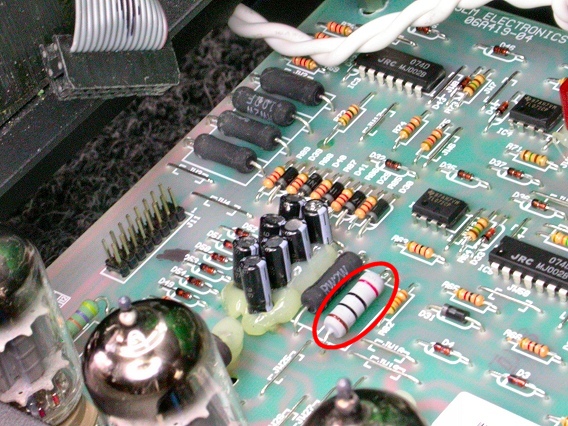| BustedGear.com |
| Shop | Repairs | Manufacturers | Resources | iFAQs | About |
|
|
|||
| Ampeg® SVT Classic | 4: Fixing the Problem | ||
|---|---|---|---|
|
Last Page < |
Page Bottom ∨ |
Next Page > |
|
|
|
|||
|
This Ampeg SVT-CL kept shutting itself off soon after being powered on. By monitoring the DC voltages on the pins of the six output tubes during shutdown, the problem was traced to an open cathode resistor. The bad resistor kept one of the output tubes from conducting current, causing its normally low cathode voltage to rise. In this photo, the six cathode resistors are located within the red circle. |

|
|---|---|
|
Here's a close-up showing five of the six cathode resistors. The bad resistor has already been removed. |

|
|
Here, a new resistor (circled in red) has been installed. The original resistor was a 10 ohm, 2 watt, 1% tolerance part. At the time, we could only find 2% resistors so we picked one whose resistance measured within 1% of 10.0 ohms. Now, we stock a 10Ω, 3W, 1% resistor for the Ampeg SVT-CL output tube cathodes. They're available on our Resistor Page and are rated at 3 watts instead of 2 so they can tolerate a bit more heat. |

|
|
The SVT-CL fault-detection circuitry (right) monitors the voltages across each of the six cathode resistors (outlined in green). If a tube were to short out, the increased current through its cathode resistor would cause the voltage across it to rise enough to trip a voltage comparator. The comparator's output voltage would then open an electro-mechanical switch, shutting off the amp's main ac power. In this SVT, no tube shorted out. Instead, a cathode resistor stopped conducting. Without a source of electrons, the tube's cathode voltage floated up toward that of its plate. That rising voltage shut down the amp and caused the Standby-Fault LED to flash. |

|
|
After reassembling and warming up the amp, be sure to set the two bias trimmers on the rear panel. If everything's good, there should be no problem getting the two green LEDs to light. |

|
| Ampeg® SVT Classic | ||
|---|---|---|
|
Last Page < |
Page Top ∧ |
Next Page > |
|
|
|
|
|
Page design and content Copyright © Richard Diemer - All rights reserved |